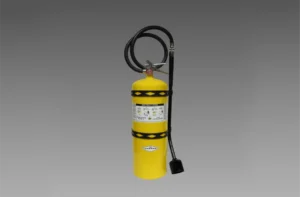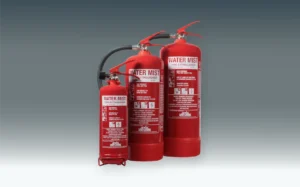
Class D Powder Fire Extinguishers
Class D Powder extinguishers are ideal for metal fires, with two types of powder available: M28 and L2
Best for Classes of Fire: A, F
Home / Fire Fighting Equipment / Fire Extinguishers / Wet Chemical Fire Extinguishers
Wet Chemical fire extinguishers are what is always recommended where there are fires involving fats and burning oils, such as restaurants, fish and chip shops, etc. It is a water-based extinguisher with an additive that creates a foaming liquid, a foam which sits over the burning oil and can be used in the high temperatures that oil burns at.

Although foam also produces a film, foam is not suitable for burning fats as it cannot cope with the high temperatures that are generated in a fire involving fats. The wet chemical extinguisher also has a specialist nozzle for applying it, so, the foam comes out as more of a gentle spray rather than a jet, reducing the risk of burning fats, splashing and igniting other areas. It is an extremely messy extinguisher, but it is really the only method we would recommend where there are fires involving burning fats. If you’ve got a fire involving fats of that type, you’re going to have an awful mess in any case, and this isn’t going to make it much worse.
They are expensive to buy and expensive to refill because of the cost of the additive. But when the applications where there is a risk of burning fats. It is the only alternative. You can get a variety of sizes, but we would always recommend no less than a six-litre size in any commercial kitchen.
Contact us now to learn more about Wet Chemical fire extinguishers and how they can be an essential part of your fire safety plan.
Wet chemical fire extinguishers are primarily designed for use on Class F fires, which involve cooking oils and fats. They are effective in suppressing fires in commercial kitchens and restaurants.
Wet chemical extinguishers work by forming a soapy foam blanket on the surface of burning cooking oil or fat. This blanket suppresses the release of flammable vapors and cools the fire, preventing re-ignition.
While wet chemical extinguishers are specifically designed for Class F fires, they can also be effective on Class A (ordinary combustibles) fires. However, they may not be suitable for use on electrical or flammable liquid fires.
Wet chemical fire extinguishers, like other types, should be inspected monthly to ensure they are in proper working condition. Additionally, they should undergo an annual professional inspection and maintenance to comply with regulations.
Regular visual inspections are crucial. Ensure that the pressure gauge is in the green zone, indicating proper pressure. Check for any physical damage, and make sure the nozzle and hose are clear. Shake the extinguisher gently to prevent the chemical powder from settling.
Wet chemical extinguishers are not recommended for electrical fires. They may conduct electricity and pose a risk to the user. For electrical fires, it is better to use a CO2 or ABC powder extinguisher.
It is generally recommended to stand at a safe distance, which is usually around 6 to 8 feet (1.8 to 2.4 meters). Follow the instructions on the extinguisher and aim the nozzle at the base of the flames while using a sweeping motion.
Wet chemical extinguishers are designed for indoor use. If a fire occurs outdoors, it is advisable to use an extinguisher specifically labelled for outdoor use or one that is versatile for multiple fire classes.
Don’t hesitate to reach out to us, or you can easily fill out the form below. We’re here to assist you.


Class D Powder extinguishers are ideal for metal fires, with two types of powder available: M28 and L2

work on various fires, including liquids and electrical equipment, by emitting a cooling mist to suppress and contain the fire.

are used to put out fires in wood, paper, and similar materials. They work by cooling down the fire and
